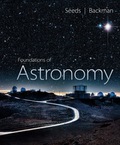
EBK FOUNDATIONS OF ASTRONOMY
14th Edition
ISBN: 8220106820612
Author: Backman
Publisher: YUZU
expand_more
expand_more
format_list_bulleted
Concept explainers
Question
Chapter 17, Problem 3P
To determine
The wavelength shifts and whether it is redshifts or blueshifts.
Expert Solution & Answer
Trending nowThis is a popular solution!

Students have asked these similar questions
Example
Two charges, one with +10 μC of charge, and
another with - 7.0 μC of charge are placed in
line with each other and held at a fixed distance
of 0.45 m. Where can you put a 3rd charge of +5
μC, so that the net force on the 3rd charge is
zero?
*
Coulomb's Law Example
Three charges are positioned as seen below. Charge
1 is +2.0 μC and charge 2 is +8.0μC, and charge 3 is -
6.0MC.
What is the magnitude and the direction of the force
on charge 2 due to charges 1 and 3?
93
kq92
F
==
2
r13 = 0.090m
91
r12 = 0.12m
92
Coulomb's Constant: k = 8.99x10+9 Nm²/C²
✓
Make sure to draw a Free Body Diagram as well
Chapter 17 Solutions
EBK FOUNDATIONS OF ASTRONOMY
Ch. 17 - Is cosmology the study of the Universe, the...Ch. 17 - Is a cosmologist an astronomer? Is an astronomer a...Ch. 17 - How does the darkness of the night sky tell you...Ch. 17 - Explain the differences among the observable...Ch. 17 - Prob. 5RQCh. 17 - Prob. 6RQCh. 17 - Prob. 7RQCh. 17 - Prob. 8RQCh. 17 - Prob. 9RQCh. 17 - Prob. 10RQ
Ch. 17 - Prob. 11RQCh. 17 - If you accept the cosmological principle, how can...Ch. 17 - Why cant an open universe have a center? How can a...Ch. 17 - In which type of model universe is space-time...Ch. 17 - In which type of model universe is space-time...Ch. 17 - What is the fate of a closed universe? In what...Ch. 17 - In which model universe does the average density...Ch. 17 - Prob. 18RQCh. 17 - What evidence shows that the Universe is...Ch. 17 - Why couldnt atomic nuclei exist when the Universe...Ch. 17 - Why are measurements of the current density of the...Ch. 17 - What percentage of matter is ordinary matter? What...Ch. 17 - How does the inflationary universe hypothesis...Ch. 17 - Prob. 24RQCh. 17 - What is the evidence that the Universe was...Ch. 17 - Prob. 26RQCh. 17 - If the Universe is negatively curved, and dark...Ch. 17 - What is the difference between hot dark matter and...Ch. 17 - Prob. 29RQCh. 17 - What evidence can you cite that the Universe's...Ch. 17 - Prob. 31RQCh. 17 - Reasoning by analogy often helps make complicated...Ch. 17 - Prob. 33RQCh. 17 - In science, wishing something to be true does not...Ch. 17 - Prob. 1PCh. 17 - Prob. 2PCh. 17 - Prob. 3PCh. 17 - Measure the lengths of the two arrows in the left...Ch. 17 - Prob. 5PCh. 17 - Prob. 6PCh. 17 - Find the wavelength of maximum intensity of the...Ch. 17 - Prob. 8PCh. 17 - Prob. 9PCh. 17 - Prob. 10PCh. 17 - Prob. 11PCh. 17 - Prob. 12PCh. 17 - Prob. 1SOPCh. 17 - Prob. 2SOPCh. 17 - Prob. 1LTLCh. 17 - Prob. 2LTLCh. 17 - Prob. 3LTLCh. 17 - Prob. 4LTLCh. 17 - Prob. 5LTLCh. 17 - Prob. 6LTL
Knowledge Booster
Learn more about
Need a deep-dive on the concept behind this application? Look no further. Learn more about this topic, physics and related others by exploring similar questions and additional content below.Similar questions
- RT = 4.7E-30 18V IT = 2.3E-3A+ 12 38Ω ли 56Ω ли r5 27Ω ли r3 28Ω r4 > 75Ω r6 600 0.343V 75.8A Now figure out how much current in going through the r4 resistor. |4 = unit And then use that current to find the voltage drop across the r resistor. V4 = unitarrow_forward7 Find the volume inside the cone z² = x²+y², above the (x, y) plane, and between the spheres x²+y²+z² = 1 and x² + y²+z² = 4. Hint: use spherical polar coordinates.arrow_forwardганм Two long, straight wires are oriented perpendicular to the page, as shown in the figure(Figure 1). The current in one wire is I₁ = 3.0 A, pointing into the page, and the current in the other wire is 12 4.0 A, pointing out of the page. = Find the magnitude and direction of the net magnetic field at point P. Express your answer using two significant figures. VO ΜΕ ΑΣΦ ? Figure P 5.0 cm 5.0 cm ₁ = 3.0 A 12 = 4.0 A B: μΤ You have already submitted this answer. Enter a new answer. No credit lost. Try again. Submit Previous Answers Request Answer 1 of 1 Part B X Express your answer using two significant figures. ΜΕ ΑΣΦ 0 = 0 ? below the dashed line to the right P You have already submitted this answer. Enter a new answer. No credit lost. Try again.arrow_forward
arrow_back_ios
SEE MORE QUESTIONS
arrow_forward_ios
Recommended textbooks for you
 Foundations of Astronomy (MindTap Course List)PhysicsISBN:9781337399920Author:Michael A. Seeds, Dana BackmanPublisher:Cengage Learning
Foundations of Astronomy (MindTap Course List)PhysicsISBN:9781337399920Author:Michael A. Seeds, Dana BackmanPublisher:Cengage Learning Stars and Galaxies (MindTap Course List)PhysicsISBN:9781337399944Author:Michael A. SeedsPublisher:Cengage Learning
Stars and Galaxies (MindTap Course List)PhysicsISBN:9781337399944Author:Michael A. SeedsPublisher:Cengage Learning AstronomyPhysicsISBN:9781938168284Author:Andrew Fraknoi; David Morrison; Sidney C. WolffPublisher:OpenStax
AstronomyPhysicsISBN:9781938168284Author:Andrew Fraknoi; David Morrison; Sidney C. WolffPublisher:OpenStax
 Stars and GalaxiesPhysicsISBN:9781305120785Author:Michael A. Seeds, Dana BackmanPublisher:Cengage Learning
Stars and GalaxiesPhysicsISBN:9781305120785Author:Michael A. Seeds, Dana BackmanPublisher:Cengage Learning Horizons: Exploring the Universe (MindTap Course ...PhysicsISBN:9781305960961Author:Michael A. Seeds, Dana BackmanPublisher:Cengage Learning
Horizons: Exploring the Universe (MindTap Course ...PhysicsISBN:9781305960961Author:Michael A. Seeds, Dana BackmanPublisher:Cengage Learning

Foundations of Astronomy (MindTap Course List)
Physics
ISBN:9781337399920
Author:Michael A. Seeds, Dana Backman
Publisher:Cengage Learning

Stars and Galaxies (MindTap Course List)
Physics
ISBN:9781337399944
Author:Michael A. Seeds
Publisher:Cengage Learning

Astronomy
Physics
ISBN:9781938168284
Author:Andrew Fraknoi; David Morrison; Sidney C. Wolff
Publisher:OpenStax


Stars and Galaxies
Physics
ISBN:9781305120785
Author:Michael A. Seeds, Dana Backman
Publisher:Cengage Learning

Horizons: Exploring the Universe (MindTap Course ...
Physics
ISBN:9781305960961
Author:Michael A. Seeds, Dana Backman
Publisher:Cengage Learning